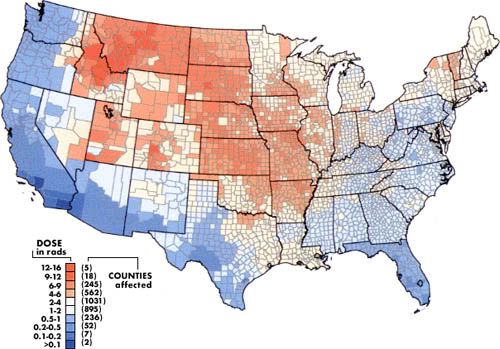
Posted on 08/08/2009 10:51:49 PM PDT by ErnstStavroBlofeld
He wasn’t supposed to do it, but on May 15, 1948, Lieutenant Colonel Paul H. Fackler, commanding officer of the U.S. Air Force 514th Reconnaissance Squadron Weather, flew his airplane into the seething mushroom cloud of an atomic bomb detonation. As part of Zebra, the final shot of America’s second series of atomic tests at Enewetak atoll in the Pacific, Fackler had the job of tracking the atomic cloud from at least 10 miles away, hoping that special filters attached to the airplane would catch samples of the radioactive debris. But as he pulled away from the enormous roiling cloud in a climbing turn to the left, Fackler suddenly found his weather reconnaissance Boeing WB-29 inside a small finger-like projection of the main cloud.
“No one keeled over dead, and no one got sick,” Fackler reported later, according to History of Air Force Atomic Cloud Sampling, a government document published in January 1963. He promptly left the cloud and continued his normal flight profile until his radiation safety officer, sitting in the B-29’s nose monitoring radiation levels, announced the crew had reached their exposure limit: 100 milliroentgens, the amount a person receives annually from naturally occurring radiation from the sun and the soil. It was time to break off and head home to the air base on Kwajalein, in the Marshall Islands. Fackler flew through a few rainshowers to wash off radioactive particles.
Aside from the unstated objective of geopolitical saber-rattling, the main purpose of atomic bomb tests was to try out new weapon designs and improve existing bombs. Analyzing the tiny particles of fallout, trace elements, and short-lived radioisotopes unleashed by the nuclear reactions was the only way to get definitive data on just what had happened inside the multi-million-degree heart of an atomic explosion. But collecting that debris in the aftermath of the explosion was a challenge.
During the first postwar test series, Operation Crossroads in 1946, specially trained pilots in mothership aircraft guided unmanned drones through clouds of two consecutive explosions from a safe distance. The drones, retired Boeing B-17 bombers and Grumman F6F fighters, had boxes mounted on the fuselage or wings, lined with filter paper designed to catch radioactive particles.
Controlling the drones was tricky even under the best conditions, much less in the turbulence following a nuclear blast. Drones often crashed or went astray, and even when everything worked properly, they couldn’t always collect the high-quality samples craved by the physicists and radio-chemists at Los Alamos labs in New Mexico and Lawrence Livermore laboratory in California. All a controller could do was point his drone at the cloud and send it through blindly, hoping that by sheer luck the drone would catch a good sample and survive the landing.
But Fackler’s stunt—whether purposeful or accidental, no one ever knew for sure—had raised an intriguing prospect. By the time the United States began the Ranger series of atomic tests at the new Nevada test site in 1951, Fackler and some supportive colleagues had convinced the military and the Atomic Energy Commission to try manned sampling flights. Monitoring aircraft could vector manned aircraft into the parts of a cloud most likely to yield good samples, and manned craft could respond to rapidly changing conditions much faster than a remote-controlled craft.
The second atomic bomb to detonate in the United States was triggered at 5:45 a.m. on January 27, 1951 (Trinity, the first, exploded near Alamogordo, New Mexico, on July 16, 1945), and at the time, Fackler was piloting a WB-29 toward the mushroom cloud. He depressurized the aircraft cabin and the crew went on 100 percent oxygen to avoid inhaling radioactive dust. Then Fackler took the aircraft through the cloud. He made a second pass, and then the radiation safety officer told him they were nearing their milliroentgen limit—the mission was over. Another sampling aircraft followed Fackler’s through each of Operation Ranger’s four remaining atomic blasts.
I would rather be on the ground than in the air when one of those bombs went off.
I’d rather be on the ground thousands of miles away and out of sight of a mushroom cloud for fear of having a heart attack at age 23.
“the crew had reached their exposure limit: 100 milliroentgens, the amount a person receives annually from naturally occurring radiation from the sun and the soil. It was time to break off and head home...”
Guess they stayed indoors for the next 365 days.
A single x-ray exposure a patient is exposed to approximately 20 milliroentgens of radiation.
That would be impossible because fallout knows no borders
Fallout would be everywhere after a major nuclear exchange.
Well, I liked my joke anyway.
This is not true. There are “nuclear-free zones.” /half-joking



The first colored map is a National Cancer Institute study sstimating Thyroid Doses of I-131Received by Americans from Nevada Atmospheric Nuclear Bomb Tests
Disclaimer: Opinions posted on Free Republic are those of the individual posters and do not necessarily represent the opinion of Free Republic or its management. All materials posted herein are protected by copyright law and the exemption for fair use of copyrighted works.